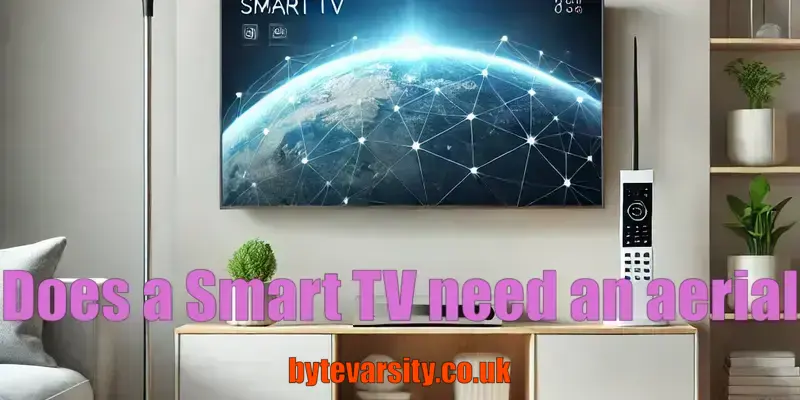Introduction – Understanding Smart TVs and Their Requirements
Smart TVs have revolutionized the way we watch television by integrating internet connectivity and streaming apps directly into the television. Unlike traditional TVs, Smart TVs allow users to access a wide range of content over the internet, from streaming services like Netflix and Amazon Prime to browsing the web. However, when it comes to receiving TV signals, many users may wonder if they still need an aerial.
In this article, we’ll explore whether a Smart TV requires an aerial to solve TV signal problems, what alternatives exist, and how to optimize your Smart TV for the best viewing experience. Let’s dive into understanding the different ways Smart TVs work and what they need to function properly.
How Smart TVs Receive Signals
Smart TVs come equipped with the technology to connect to the internet, which allows them to stream content from various platforms. These TVs typically feature built-in Wi-Fi or Ethernet ports to connect to a home network. This means that a Smart TV doesn’t necessarily require an aerial to access internet-based content, such as streaming videos, music, or even live events.
However, Smart TVs can still tune into traditional broadcast signals if they have a built-in digital tuner. This is where the confusion often arises. While Smart TVs are designed to connect to streaming services via the internet, some models also come with the capability to receive over-the-air signals, which means an aerial may still be necessary for users who wish to access free-to-air broadcast channels.
The signal source for a Smart TV depends on what you’re trying to watch. If you’re primarily interested in streaming, the internet connection becomes the key requirement. However, for traditional TV channels, especially if you’re using an antenna or aerial, a compatible tuner is needed.
Does a Smart TV Need an Aerial for TV Channels?
For many people, the answer to whether a Smart TV needs an aerial boils down to how they intend to watch television. If you’re using a Smart TV to stream content via services like Netflix, Hulu, or Disney+, you do not need an aerial. Streaming services rely on your internet connection to deliver content, so there’s no need for a traditional TV signal.
However, if you want to watch free-to-air television channels (like BBC, ITV, or Channel 4 in the UK), you’ll likely need an aerial. This is because Smart TVs with built-in tuners are designed to pick up over-the-air broadcast signals, just like traditional TVs. In this case, the aerial serves as the antenna for receiving digital TV signals.
For users who are used to the convenience of cable or satellite TV, the Smart TV might still require a separate set-top box for accessing channels. But if your primary goal is to watch local broadcast channels, an aerial is essential.
Alternatives to Using an Aerial with a Smart TV
If you’re looking to bypass the need for an aerial, there are several alternatives that can help you access TV channels or live programming on your Smart TV. One of the most popular solutions is using streaming devices like Roku, Amazon Fire Stick, or Apple TV. These devices plug into your TV’s HDMI port and offer access to a wide range of content, including live TV streaming services.
Many streaming services, such as Sling TV, YouTube TV, and Hulu + Live TV, offer live television programming without the need for an aerial. These services typically require a subscription, but they often include local channels, sports, news, and other content available through traditional broadcast.
Another option is subscribing to cable or satellite TV providers that offer apps for Smart TVs. Most major cable providers have apps that let you stream TV channels directly to your Smart TV, without requiring an aerial or set-top box.
For users who prefer traditional broadcast but want to avoid an aerial, a digital TV tuner box can be another option. These devices can connect to your Smart TV and pick up signals, allowing you to watch free-to-air channels without the need for a full antenna setup.

Solving TV Signal Problems with Your Smart TV
If you’re experiencing poor signal reception on your Smart TV and are relying on an aerial, there are several troubleshooting steps you can take to resolve the issue. One of the most common problems is poor placement of the aerial. Make sure the aerial is placed in an area with minimal interference and is directed towards the nearest transmission tower.
Additionally, check that the aerial cables are securely connected to both the TV and the aerial itself. Loose connections can cause weak signals or no signal at all. If you’re using a digital tuner, make sure it is properly configured and that the TV is set to the correct input source.
For users facing persistent signal issues, upgrading to a higher-quality aerial or using a signal booster might help improve reception. External signal boosters amplify weak signals, which can be especially helpful if you’re located far from broadcast towers or in areas with poor signal coverage.
If all else fails, consider using a cable or satellite service for more reliable access to TV channels, as these typically do not rely on aerials for signal reception.
Conclusion – Do You Really Need an Aerial for Your Smart TV?
In conclusion, whether a Smart TV requires an aerial depends on how you plan to use it. If you’re focused on streaming content via the internet, no aerial is necessary. However, if you want to access traditional TV channels, particularly free-to-air broadcasts, you’ll need an aerial or an alternative solution like a digital TV tuner or streaming device.
Ultimately, Smart TVs are designed to offer flexibility, allowing you to enjoy both internet-based content and traditional TV channels. By understanding the different ways a Smart TV can function, you can make an informed decision on whether you need an aerial or if there are better alternatives for your viewing needs.